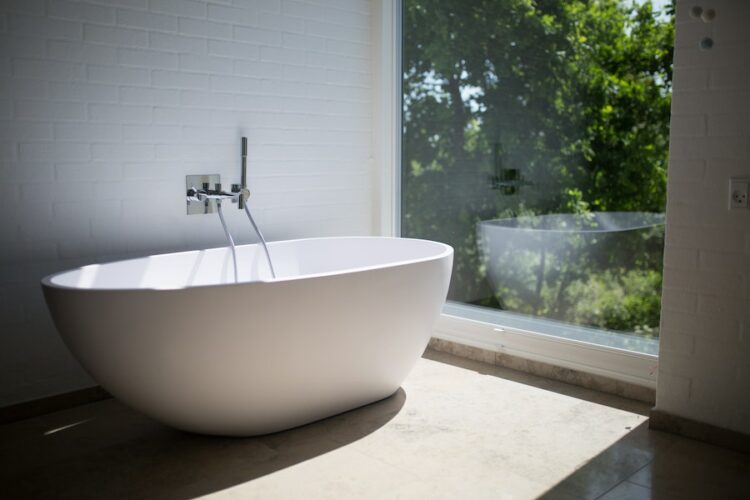A bathtub drain with holes can be a frustrating and potentially damaging issue in any home. These holes can lead to leaks, water damage, and even pose health hazards due to moisture accumulation. In this comprehensive guide, we will explore the common causes of bathtub drain holes, the consequences of neglecting the problem, and a step-by-step approach to repairing the damage. By following these instructions and implementing preventive measures, you can ensure the longevity of your bathtub drain and maintain a leak-free and safe bathing experience.
How To Plug A Bathtub Drain With Holes?
When dealing with a bathtub drain that has holes, there are several ways to effectively plug the holes and prevent leaks. The method you choose depends on the severity of the holes and your comfort level with DIY repairs. Here are some ways to plug a bathtub drain with holes:
- Epoxy Putty: For small to moderate-sized holes, epoxy putty can be an effective solution. It is a moldable substance that hardens into a waterproof seal. Clean the drain and surrounding area thoroughly, then apply the epoxy putty over the holes, following the manufacturer’s instructions.
- Silicone Sealant: Silicone sealant is ideal for smaller holes and cracks. Ensure the area is clean and dry, then apply the sealant directly over the holes. Press down firmly to create a tight seal and allow it to cure as per the product’s recommendations.
- Bathtub Patch Kit: Some hardware stores offer specialized patch kits designed for bathtub drain repairs. These kits often include various materials, such as adhesive patches or mesh, along with waterproof sealants to provide a durable fix.
- Drain Cover or Stopper: If the holes are relatively minor and not causing significant issues, you can opt for a temporary solution by using a drain cover or stopper to prevent water from escaping through the holes.
- Replace Drain Components: If the holes are extensive and the drain is severely damaged, consider replacing the drain components entirely. You may need to uninstall the old drain and install a new one, which can be a more involved process, so it’s best to seek professional help if unsure.
Understanding Bathtub Drains With Holes
Understanding bathtub drains with holes is crucial for homeowners to address the issue effectively and prevent potential water damage and safety hazards. Bathtub drains develop holes due to various reasons, including wear and tear over time, corrosion, or the use of harsh chemicals. In some cases, the holes may be caused by small cracks that have developed into more significant openings over time. Understanding the causes helps homeowners take appropriate preventive measures and identify the best repair approach.
The consequences of leaving a bathtub drain with holes unaddressed can be severe. Holes in the drain allow water to seep into the surrounding areas, leading to moisture accumulation, mold growth, and potential damage to the structure of the bathroom floor or walls. Additionally, the water leaking from the holes may not be adequately draining, creating standing water in the bathtub that can be a breeding ground for bacteria. This can pose health risks to household members, especially those with compromised immune systems or respiratory issues. Furthermore, the continuous leakage of water can result in higher water bills, wasting both water and money.
There are various types of bathtub drain holes, ranging from small pinholes to larger cracks. The severity of the holes determines the best course of action for repair. Minor holes can often be addressed with DIY solutions, such as epoxy putty or silicone sealant, while more significant damage may require replacing the drain components entirely. Properly identifying the type and extent of the holes is crucial for choosing the most suitable repair method and ensuring a successful fix that restores the drain’s functionality and prevents future issues.
Preventive Measures For Bathtub Drain Maintenance
Preventive measures for bathtub drain maintenance are essential to keep the drain system in optimal condition and prevent the development of holes or other issues. Regular maintenance can help extend the lifespan of the drain and avoid costly repairs. Here are some preventive measures to consider:
- Regular Cleaning: Regularly clean the bathtub drain and surrounding area to prevent the buildup of soap scum, hair, and debris that can clog the drain and contribute to corrosion over time. Use a drain brush or a bent wire hanger to remove any visible buildup.
- Use Drain Covers or Stoppers: Place drain covers or stoppers over the drain opening when using the bathtub to prevent hair, debris, and other objects from going down the drain. This reduces the risk of clogs and potential damage to the drain.
- Avoid Harsh Chemicals: Refrain from using harsh chemicals or drain cleaners to clear clogs. These chemicals can corrode the drain components and contribute to the development of holes. Instead, use natural alternatives like baking soda and vinegar or invest in a drain snake for clearing clogs.
- Be Mindful of Bath Additives: Be cautious when using bath additives like bath salts or oils. Some additives can leave residues that may accumulate in the drain, leading to clogs or damage over time. Rinse the drain thoroughly after each use if you use bath additives regularly.
- Regular Inspections: Periodically inspect the bathtub drain for any signs of wear, corrosion, or leaks. Look for rust spots, discoloration, or unusual odors around the drain area, as these could be signs of potential issues.
- Install a Drain Strainer: Consider installing a drain strainer or catch basin over the drain opening to trap hair and debris before they enter the drain. This can significantly reduce the risk of clogs and prolong the life of the drain.
- Professional Maintenance: If you notice any problems or suspect damage to the drain, don’t hesitate to seek professional help. A plumber can conduct a thorough inspection and perform any necessary repairs or maintenance to keep the drain in top shape.
Tips For Keeping The Drain And Surrounding Area Clean
Keeping the drain and surrounding area clean is essential to prevent clogs, maintain a hygienic bathroom environment, and prolong the life of the drain system. Here are some tips for keeping the drain and its surroundings clean:
- Regular Cleaning Routine: Incorporate the drain and surrounding area into your regular bathroom cleaning routine. Clean the bathtub surface, tiles, and the area around the drain to prevent the buildup of soap scum, grime, and mildew.
- Use Natural Cleaners: Avoid using harsh chemical cleaners that can damage the drain and the environment. Instead, use natural cleaning solutions like baking soda and vinegar to dissolve soap scum and remove stains. These alternatives are effective and environmentally friendly.
- Brush or Plunge the Drain: Periodically use a drain brush or a plunger to remove any visible buildup around the drain opening. This will help prevent clogs and improve drainage.
- Install a Drain Strainer: Consider installing a drain strainer or catch basin over the drain opening to trap hair, debris, and other objects. Empty the strainer regularly to keep the drain free from clogs.
- Use Drain Covers: When using the bathtub, place a drain cover or stopper over the drain to prevent hair and debris from going down. This simple measure can significantly reduce the risk of clogs and keep the drain clean.
When To Call A Professional Plumber?
Calling a professional plumber is essential when dealing with certain plumbing issues that may be beyond your expertise or require specialized tools and knowledge. Here are some situations when you should consider calling a professional plumber:
- Persistent Clogs: If you’ve tried DIY methods like using a plunger or drain snake, but the clog persists, it’s time to call a plumber. Persistent clogs could indicate a more severe blockage deep within the plumbing system that requires professional equipment to remove.
- Multiple Clogged Drains: If you notice that multiple drains in your home are clogged simultaneously, it could be a sign of a more significant plumbing issue, such as a main sewer line blockage. A professional plumber can diagnose and address the problem effectively.
- Sewer Line Problems: Issues with the main sewer line, such as sewer backups, foul odors, or slow drainage throughout the house, require immediate attention from a professional plumber. Sewer line problems can be complex and may involve digging or specialized camera inspections to identify and fix the issue.
- Water Leaks: If you notice water leaks around the bathtub drain, in the walls, or under the floor, it’s essential to call a plumber right away. Water leaks can cause structural damage, and mold growth, and lead to high water bills if left unaddressed.
- Low Water Pressure: Persistently low water pressure can be an indication of various issues, such as pipe blockages or a problem with the water supply. A professional plumber can identify the cause and recommend the appropriate solution.
Conclusion
In conclusion, upgrading your plumbing system is a wise investment that brings a range of benefits. From increased efficiency and reduced water waste to improved safety and long-term savings, modernizing your plumbing helps prevent future issues, enhances your home’s value, and provides peace of mind. By taking this proactive step, you can enjoy a more efficient, reliable, and eco-friendly plumbing system for years to come.
FAQ’s
Why Is My Bathtub Drain Slow To Empty?
Slow draining in a bathtub can be caused by various factors, such as hair and soap scum buildup, clogs deep within the drainpipe, or a partially closed drain stopper. Using a plunger, drain snake, or a mixture of baking soda and vinegar can often help clear minor clogs. If the problem persists, it may require professional assistance to identify and address the underlying issue.
Can I Use Chemical Drain Cleaners To Clear A Clog?
While chemical drain cleaners can be effective in clearing clogs, they can also be harsh on your plumbing system and the environment. Chemicals may corrode pipes and cause long-term damage. It’s best to avoid using them regularly and opt for more natural methods, such as baking soda and vinegar, or contact a plumber to handle stubborn clogs.
What Should I Do If My Bathtub Drain Is Leaking?
If you notice water leaking around the bathtub drain, it’s essential to address the issue promptly. Start by checking if the drain components are properly connected and tightened. If the problem persists, it could indicate worn-out seals or damaged components that need replacement. In such cases, it’s best to call a professional plumber to identify and fix the source of the leak.
How Can I Prevent My Bathtub Drain From Developing Holes?
To prevent your bathtub drain from developing holes, adopt preventive measures such as using drain covers or stoppers to prevent hair and debris from entering the drain. Avoid using harsh chemicals that can corrode the drain, and be mindful of the bath additives you use to prevent residue buildup. Regularly inspect the drain and its surroundings for signs of wear or damage, and schedule professional maintenance when necessary.
When Should I Consider Replacing My Bathtub Drain?
Consider replacing your bathtub drain when it has significant damage or extensive corrosion that cannot be effectively repaired. If the drain is causing persistent leaks despite repair attempts or if the fixture is outdated and no longer functions optimally, replacement may be the best option. A professional plumber can assess the condition of your drain and recommend the appropriate course of action.







